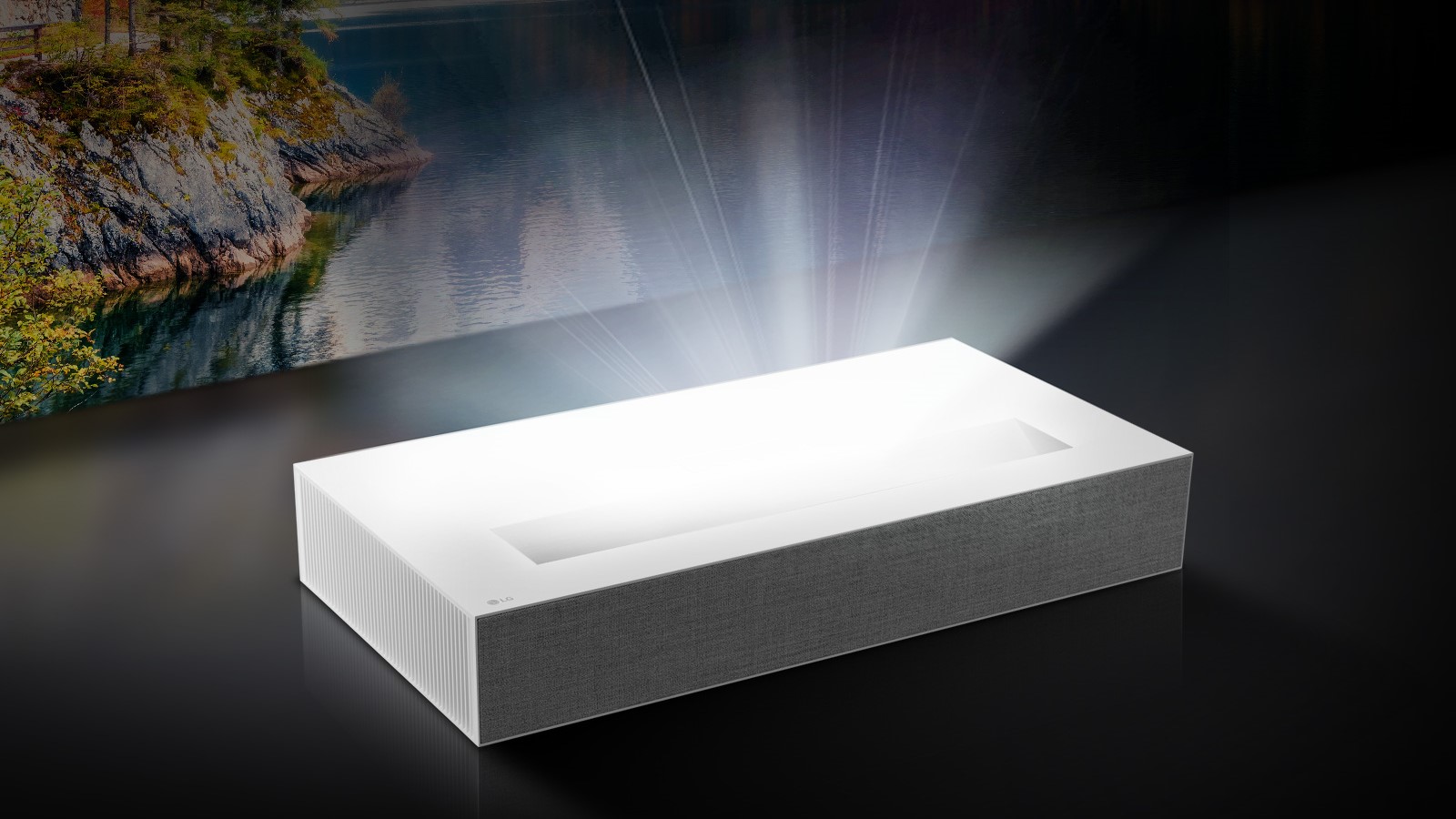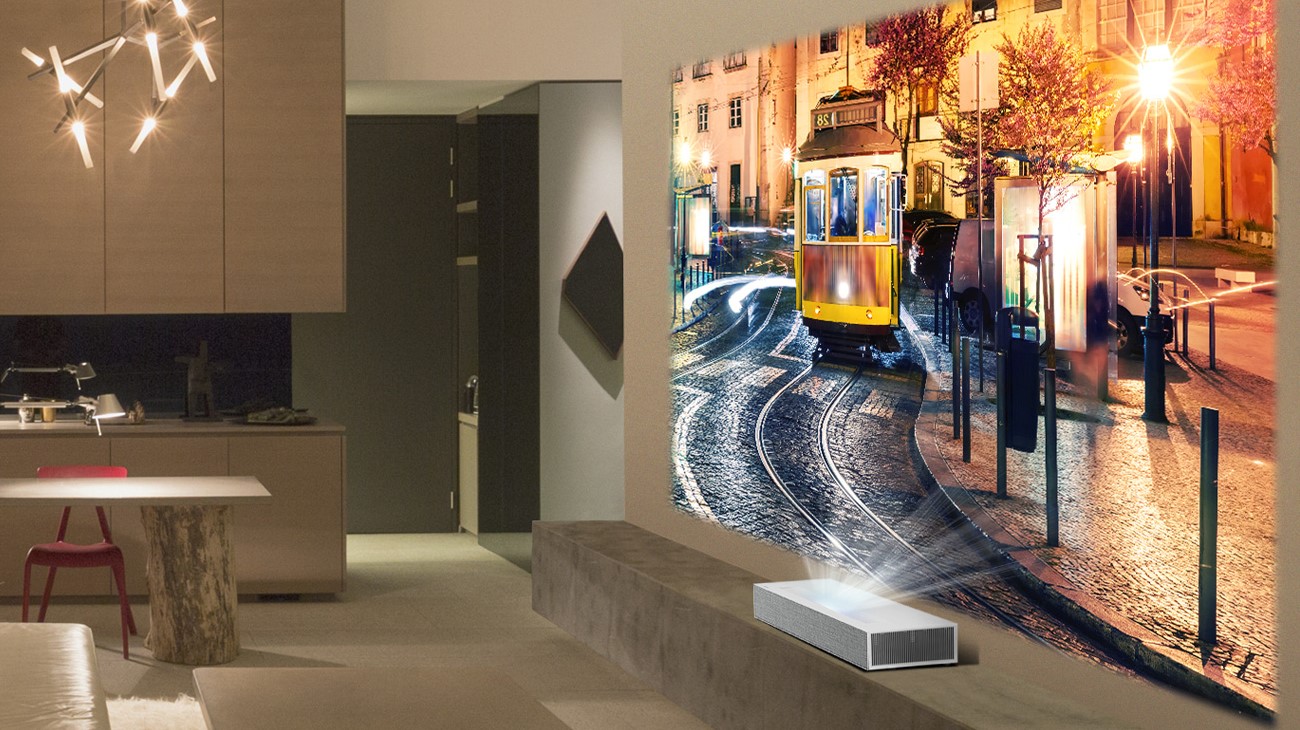TechRadar Verdict
The LG HU85LA CineBeam ultra short-throw projector is at the cutting edge of projection technology and boasts a stunning image quality - but you can find traditional projectors that look just as good for cheaper.
Pros
- +
Excellent image quality
- +
LG’s WebOS is great
- +
Classy design
- +
Super smart features
Cons
- -
You’ll need nicer speakers
- -
Expensive
Why you can trust TechRadar
Over the last few years, LG has pumped out a series of groundbreaking TV models that arguably redefine what to expect from a TV, from the LG OLED W-Series Wallpaper TV to the rollable TV that it showed off at CES.
But while they may not get as much press, the company is doing the same thing with projectors - and, earlier this year, it announced a newly re-designed ultra short-throw projector called the LG HU85LA CineBeam ThinQ.
If you’re unfamiliar with the concept of a short-throw projector, it’s essentially a projector that you can place next to the wall, and it’ll angle the image up at the wall it’s next to. It’s a significant shift from what you would expect from a traditional projector and makes projection technology a whole lot more convenient.
The downside? The LG HU85LA CineBeam is also relatively expensive and doesn't have the nicest speakers. So is it worth the cash? We’ve been using the arguably groundbreaking new projector for the past few weeks to find out.

Design
At $6,000 (around £4,860, AU$8,750), you would expect the LG HU85LA to look good - and look good it does. The projector sits in at 26.8 inches wide, 13.7 inches deep, and 5 inches tall, which is actually pretty compact. Sure, there are plenty of 4K projectors that are smaller than this one, but those projectors aren’t short throw projectors like this one is.
Generally speaking, the projector is basically a big rectangle, but it’s super modern-looking, and the white color-scheme with the gray speaker covering looks great. That said, some might prefer an all-back design instead of the all-white look, however there doesn’t seem to be any options other than white.
Once set up, the LG HU85LA will look right at home in any home theater: On the front of the device, there’s a nice-looking fabric covering, which covers the built-in speaker and status lights for the projector. On the top, there’s an adjustment for the projector’s focus, and on the back you’ll find the ports for the projector.
Sign up for breaking news, reviews, opinion, top tech deals, and more.
Out of the box, you’ll get plenty of connectivity, including two HDMI ports and two USB ports, which can be used for both media playback and power delivery. There’s also a USB-C port, which is a nice touch. Under the projector, on the front-right, there’s a small joystick that can be used to power on the projector and control channels and volume.
The LG Magic Remote, which comes with the projector, actually works kind of like a Wii remote, allowing the user to point at the display to make selections. It works pretty well, and ensures that you can quickly make selections without having to scroll through menus. The remote is around six inches long, and has controls for channels, volume, playback, and quick-access buttons for Netflix and Amazon Prime Video. There’s also a scroll wheel in the middle of the directional pad, which doubles as a selector button like a scroll wheel would on a mouse.
It’s generally a good experience, and there are controls for everything you would need. Sure, it’s not as simple as something like the Apple TV remote, but most will be able to easily figure out what each button does, and how to use it.

Setup and software
Setting up the LG HU85LA is an absolute breeze: You’ll start by placing the projector between 2.2 and 7.2 inches away from the surface that you want to display onto. That may seem like a small variation, but it actually makes a huge difference - at 2.2 inches away, the projector will deliver a 90-inch screen size, while at 7.2 inches, you’ll get a 120-inch projection.
Once placed, plug the projector in, put the batteries in the remote, and hit the on button. The projector will kick into action and you’ll be able to adjust the focus, if it’s not in focus right away.
The projector itself uses LG’s WebOS, so if you’ve used any recent LG TVs before, you’ll immediately recognize how it works. Besides offering some familiarity, WebOS is easy to navigate and looks nice and modern.
As with many other smart platforms, you can choose from a number of streaming services and access other features from the gallery. If you’re into voice controls, you can use the microphone built-in to the remote too to jump to different apps, change the volume, and more. Apart from LG’s ThinQ, the projector actually makes use of Google Assistant too - so if you’re set up in the Google ecosystem, you’ll be able to control not only the projector, but also your smart home devices and so on. It’s a handy touch, and helps make the already smart WebOS even smarter.

Performance
Often, new technology is a little hit and miss - but LG has done a great job at ensuring that this new ultra-short throw projector is ultra high-quality.
When it comes to the specs, the projector is a laser projector that offers a massive 4K resolution (3,840 x 2,160), along with 4K upscaling and support for HDR10. It also offers a 2,000,000:1 contrast ratio, and a brightness of a hefty 2,700 lumens. The projector uses a 3CH laser, which is an upgrade from dual-laser projectors, and as a result the projector is able to cover 97% of the DCI-P3 color space.
Safe to say, it’s a pretty high-tech projector, especially considering the fact that it’s short-throw.
The projector offers a few different viewing modes, as you would expect. Some modes are built for SDR, and others for HDR, and they honestly all looked pretty good. Projectors have a harder time at color accuracy than TVs do, unless you’re in a super dark environment and have a high quality projection surface. We tested the projector in a range of environments, but most of the testing was in fact done with the curtains drawn. That said, even with medium light, it actually did pretty well - so while it’s probably not something that could withstand direct sunlight, it does perfectly fine in most other situations.
Vivid was definitely the brightest mode, and a little over the top in terms of color saturation. That said, we recommend steering clear unless you really need that extra brightness.

Other modes include Standard, Cinema, Sports, and Game, and we found that the Standard or Cinema modes looked the best in most situations, with the Cinema mode probably being the best when you’re able to cut down on ambient light.
In SDR, the projector is a little less bright than it is in HDR, but it still looked great. The well-tuned eye might notice a major different and prefer making sure that the room is truly blacked out when watching SDR content, but most will still get by perfectly fine with the brightness on offer in SDR. Content in SDR actually looks great. Images are detailed and crisp, whole colors are vivid and bright. Once again, the overall image in SDR is a little darker - as you might expect - but we still absolutely loved the image quality on offer here.
In HDR, the projector is even better. Content is beautifully detailed, while colors pop. Content like David Attenborough’s Planet Earth II is an absolute joy to watch, and the huge screen size is a big part of that. I still stuck with Cinema mode here, and if you’re a pixel peeper you may notice that the image has a slightly cool tone to it - but it’s not bad by any means, and still makes for a stunning image.

Sound quality
Sound quality on the speakers is fine on its own, but you’ll probably want to match such high-quality image with high-quality speakers. We found that the sound was generally a little midsy, and there wasn’t a ton of detail in the high end, but they’re certainly passable for most situations. Again, though, for true home theaters, you’ll want to invest in something with a little more oomph.
The projector is super quiet too. There is fan noise, to be sure, but it’s easily drowned out by speakers, even at lower volumes. LG has done a great job at ensuring the projector runs largely distraction-free.
Final verdict
The LG HU85LA is an arguably groundbreaking product. Gone are the days when owning a projector meant having to hang one from the ceiling or have a permanently installed table in the middle of your living room. Sure, it’s not the first short-throw projector in general, but it is one of the first for home theaters, and we’re seriously hoping it kicks off a new wave of projectors and the tech gets cheaper over time. Until then, rest assured, if you’re interested in buying this projector and have the cash to spend, you won’t be disappointed.
That said, if you’re building a home theater and want a projector that can stay stationary, then it’s worth looking at projectors that you can hang from the ceiling. Considering how new ultra short-throw projectors are, you could probably find a traditional projector with a similar image quality for a whole lot cheaper.
- Need another option? Here's our list of the best projectors in 2019
Christian is a writer who's covered technology for many years, for sites including Tom's Guide, Android Central, iMore, CNN, Business Insider and BGR, as well as TechRadar.
